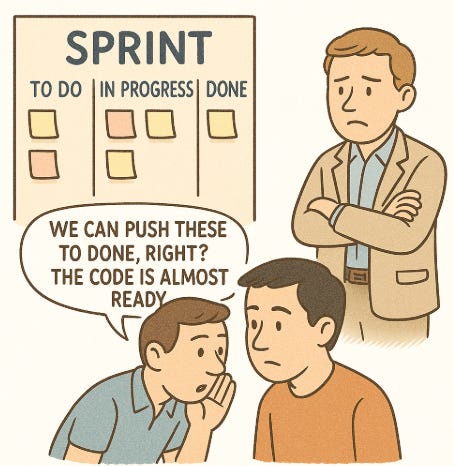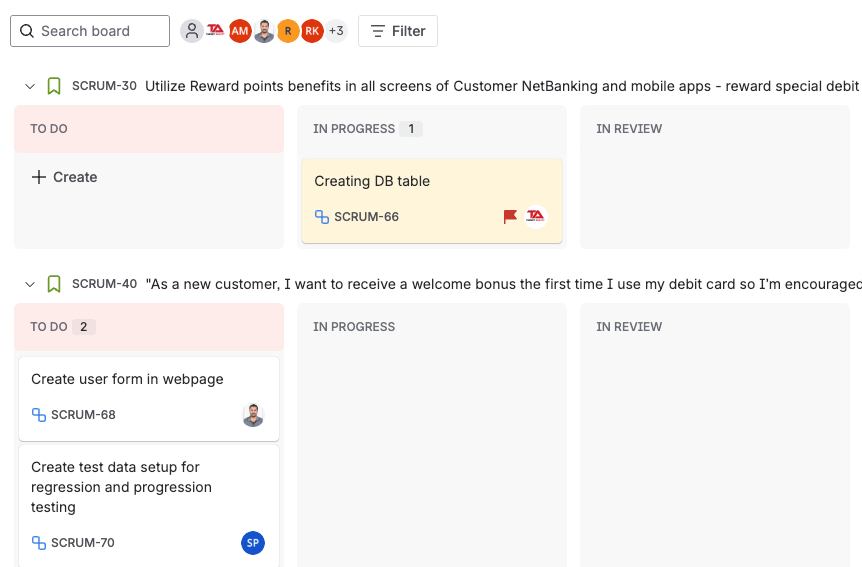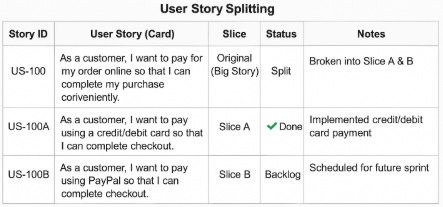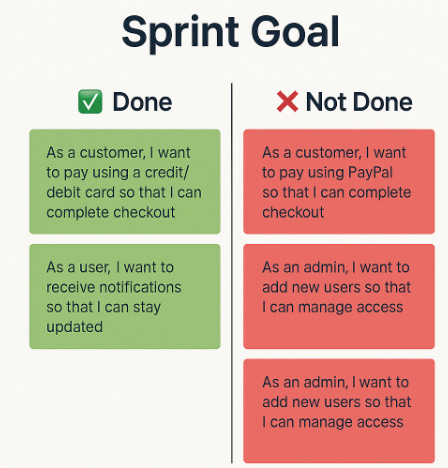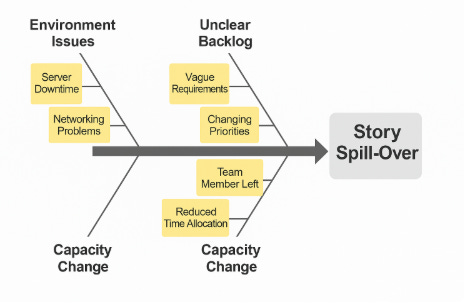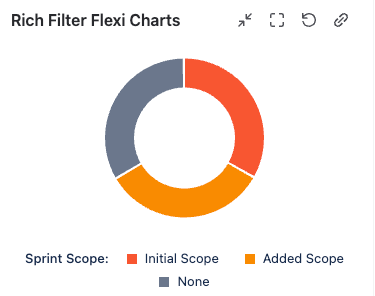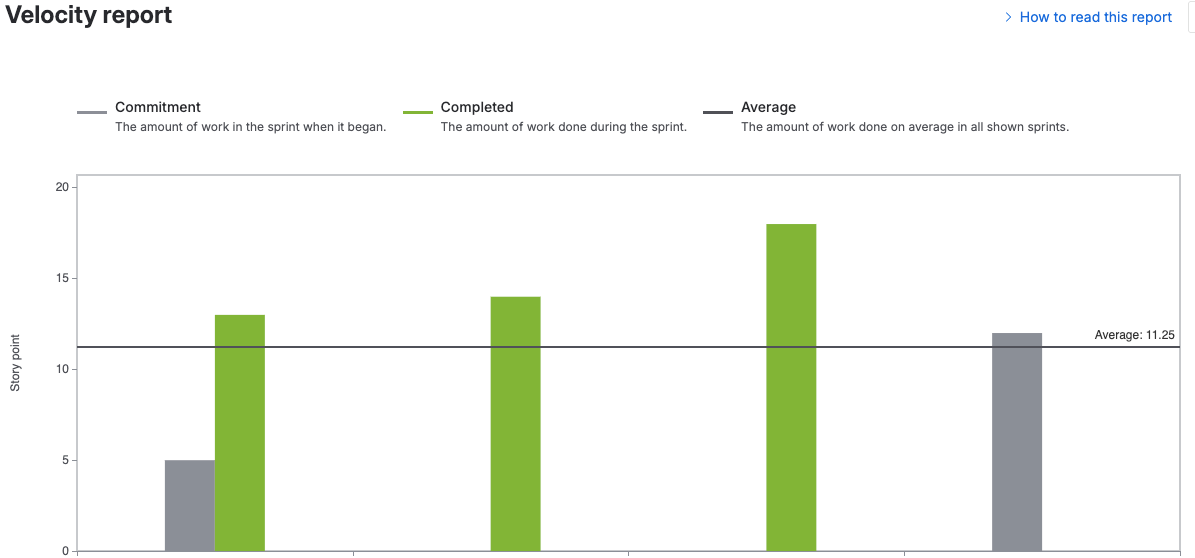The Sprint Spill-Over Playbook: How to Handle Incomplete Stories Without Chaos
How to handle spill-overs with transparency, salvage value, and protect stakeholder trust
I still remember the final day of that Sprint.
The board was filled with half-done tickets.
The Product Owner looked worried.
One developer whispered, “We can push these to Done, right? The code is almost ready.”
Leadership was expecting a demo that afternoon.
I felt the tension in my chest: if we call these “done,” we betray the Definition of Done. If we spill everything over, we look unreliable.
That’s when I realised: every Scrum Team will face unfinished stories.
What matters is how you respond — calmly, transparently, and with a plan.
Here’s the 5 Field-Tested Strategies playbook I now use and coach others to follow.
Strategy 1: Call It Early, Not at the End
Action Plan:
Daily Tracking
During each Daily Scrum, check each in-progress story against the Definition of Done (DoD).
Example: “Story #104 ‘Reset Password Flow’ has been in development for three days with no QA hand-off. Let’s flag it.”
Visual Flagging
By mid-Sprint, label risky items with a red “⚠ At Risk” tag.
Example: In Jira, add a custom field “Risk Status = High” and filter these to a separate swimlane.
Facilitated Conversation
Prompt the team: “This story is flagged. What’s blocking us? Do we need another pair of eyes?”
Example: A backend developer volunteers to help finish the database migration.
Stakeholder Heads-Up
Send a quick Slack note to PO and key stakeholders:
“Story 104 may spill over. We’ll decide by Thursday whether to slice or move it.”
Challenge: Developers hope for a last-minute miracle.
Tip I used: “Flagging early is a mark of professionalism, not failure.”
Strategy 2: Slice and Salvage
Action Plan:
Identify Core Value
Ask: “If we could only deliver one part next week, what’s the smallest slice with user value?”
Example: From “Password Reset via Email & SMS,” keep only the email path.
Create a Thin Slice Story
Split the original into “Email Reset (Slice A)” and “SMS Reset (Slice B).”
Estimate Slice B and return it to the Product Backlog.
Update Sprint Goal
Adjust to: “Enable password reset by email for all users.”
Communicate Upwards
Tell stakeholders: “To preserve quality, we’ll release email reset now and plan SMS reset next Sprint.”
Challenge: PO fears stakeholder disappointment.
Tip: Show past data where delivering a small but complete increment actually improved stakeholder trust.
Strategy 3: Stay Transparent in the Sprint Review
Action Plan:
Prep the Demo Board
Move incomplete stories to a “Carried Over” column.
Example: “SMS Reset” card clearly sits under “Not Done.”
Open with the Goal
“Our Sprint Goal was to enable password reset. Here’s what’s complete and what remains.”
Demo Only Done Work
Politely decline unfinished features:
“The SMS path isn’t production-ready, so we’re not demoing it today.”
Capture Feedback
Ask: “Any feedback on the completed email reset flow?”
Challenge: Leaders want to see the “90 % done” SMS demo.
Tip: “Showing incomplete work creates confusion and false expectations.”
Strategy 4: Run a Focused Retrospective on the Root Cause
Action Plan:
Gather Data
Export Jira cycle times, note blockers and capacity changes.
Facilitate 5 Whys
Example: “Why did SMS Reset spill over?”
Lack of test environment.
Because Ops ticket was delayed.
Because change approval board meets only weekly… etc.
Vote on Causes
Team dot-votes on “Environment readiness” as top cause.
Agree on One Action per Cause
Decide: “Ops will create a standing test environment before Sprint 8.”
Challenge: Blame game starts.
Tip: Kick off with: “We’re here to improve the system, not to find a person to blame.”
Strategy 5: Strengthen Your Forecasting Muscles
Action Plan:
Analyse Historical Velocity
Review last eight Sprints: average = 42 story points, low = 35.
Set a Planning Guardrail
Commit to plan ≤ 38 points (≈ 90 % of average).
Adjust for Known Changes
Example: Two developers are on leave next Sprint → adjust down to 32 points.
Track Spill-Over Rate
Add a metric card to your dashboard: “% Stories Carried Over: last Sprint = 12 %.”
Educate Stakeholders
Present: “When we plan at 90 % capacity, carry-over drops from 25 % to 10 %.”
Challenge: Leadership wants stretch goals.
Tip: Show the velocity trend chart and highlight how lower planned capacity increased delivered points over time.
Try This Tomorrow
In your next Daily Scrum, identify one story at risk and mark it visibly.
Notice how early transparency lowers last-day panic.
Community of Practice
Want to role-play these conversations and practice the scripts live?
Join my Community of Practice (CoP) every Saturday 5pm IST — we run 1:1 role plays and feedback.
🔗 Register here
Ready to Turn These Strategies into Action?
Join the Scrum Master Bootcamp!
If you want to internalise these moves fast, join the Scrum Master Bootcamp. In the Bootcamp we simulate pressured releases and practice these exact scripts until they feel natural.
Don’t just learn — experience the difference in real time.
📚 From My Shelf
📘 This Week’s Book: Ikigai by Héctor García & Francesc Miralles
(A gentle reminder that life is bigger than deadlines and paychecks.)
Ikigai doesn’t talk about chasing success.
It talks about finding the balance of what you love, what you’re good at, what the world needs, and what you can be paid for.
The kind of clarity that turns everyday living into meaningful purpose.
What influenced me most?
“Our ikigai is the reason we get up in the morning.”
For any Scrum Master or Product Owner stuck in the chaos of delivery—this book is a masterclass in slowing down, aligning with purpose, and rediscovering joy at work and in life.
Have you read it? What does ikigai mean for you?
Why Subscribe
Each week, I share battle-tested strategies, messy lessons, and practical tools that help Scrum Masters, Product Owners, and change agents like you make sense of chaos — without sugar-coating it.
If you found this useful, subscribe.
This isn’t theory. It’s real work, made a little easier — one step at a time.
Thanks for reading Strategy For Success! Subscribe for free to receive new posts and support my work.
“Just because I understand it, does not mean everyone understands it. And just because I do not understand it, does not mean no one understands it.”
Thanks for reading Strategy For Success! Subscribe for free to receive new posts and support my work.


